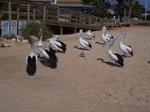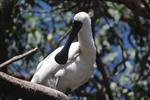Identifying Birds
Identifying Birds is a Valuable Skill for Ecotour Guides
 The first step in understanding birds is to understand how they are classified (i.e. how they are named). When you understand the groups or subdivisions which birds fall into, you will have a foundation for identifying and remembering the names of different birds which you encounter. You will also have a basis upon which to use reference material (books, web sites etc.).
The first step in understanding birds is to understand how they are classified (i.e. how they are named). When you understand the groups or subdivisions which birds fall into, you will have a foundation for identifying and remembering the names of different birds which you encounter. You will also have a basis upon which to use reference material (books, web sites etc.).
Bird names are better remembered when you can associate that name with something you are familiar with - in other words, the family to which that bird belongs.
Common names are widely used by birdwatchers, and even scientists in the field of Ornithology. Within a particular locality, scientific names are relatively accurate, though not always 100% correct.
Be careful using scientific names though, particularly when you move to other parts of the world, as their accuracy can become uncertain. Bird classification is an imperfect science. Depending upon where an expert places their emphasis, the conclusions which they reach may vary. For instance, if an expert gives more importance to similarities in physical characteristics such as the beak, rather than behaviour, they may classify birds in a particular way. Another expert who gives more emphasis to behaviour and less to physical appearance may classify the same birds differently. Also, scientists in different countries sometimes classify birds differently. For example, in Europe, magpies are commonly black and white birds with the scientific name Pica pica. In Australia, a magpie is classified as a bird belonging to the genus Gymnorhina.
Class Aves: Birds
 Birds are animals that belong to the Class Aves. Animals of this class characteristically have skin with feathers, forelimbs that are wings with three fused fingers, the hind limbs that are legs, each leg having four or less toes (usually developed into claws). All living types of birds have a horn like beak, and do not have teeth. The Class Aves includes 27 orders of living birds and a few fossil orders. Of the 27 living order 4 are ratites (flightless, usually large birds) and the remaining 24 are carinate (flying birds, with a ridge on the underside of their breastbone to which flight muscles are attached).
Birds are animals that belong to the Class Aves. Animals of this class characteristically have skin with feathers, forelimbs that are wings with three fused fingers, the hind limbs that are legs, each leg having four or less toes (usually developed into claws). All living types of birds have a horn like beak, and do not have teeth. The Class Aves includes 27 orders of living birds and a few fossil orders. Of the 27 living order 4 are ratites (flightless, usually large birds) and the remaining 24 are carinate (flying birds, with a ridge on the underside of their breastbone to which flight muscles are attached).
The bird heart has four chambers with a single aortic arch on the right and the lungs are extended air pouches. Birds do not have external genitals, external ear lobes or urinary bladders, and their urine is semi-solid.
Class Aves
- Subclass Archaeornithes
- Subclass Neornithes
- Superorder Paleognathae – non-flyers or weak flyers.
- Superorder Neognathae – modern flying birds.
Subclasses of Birds
There are two subclasses of birds:
- Subclass Archaeornithes (Archae = old ornithes = birds) is a group of extinct reptile-like birds of the late Jurassic and early Cretaceous. This includes Archaeopteryx;
- Subclass Neornithes (Neo = new/recent ornithes = birds) includes extinct and living birds with well-developed sternum usually with keel.
Learn More
Learn about birds for personal interest or for developing your career - working with birds, such as in zoos, or as an Ecotour Guide.
ACS offer a great selection of courses for developing your knowledge of birds - such as our 100 hour Ornithology course, 500 hour Proficiency Award in Ornithology, Zookeeping and Wildlife Management, or a 600 hour Certificate in Animal Science.
Our 100 hour courses offer a great way to gain a foundation of valuable knowledge, whilst qualifications can provide more extensive knowledge and skills development along with the opportunity to specialise more specifically in areas of interest to you.
Our courses are all studied by distance learning and can be started at any time. They have been developed and are taught by our highly knowledgeable and experienced tutors. If you are thinking of studying either for personal interest or for professional development get in touch with our specialist tutors today to see what courses are available to suit your study aims.
[02/01/2026 07:59:44]
More from ACS
Short courses, certificates and diplomas -lots of home study options.
Learn to care for wildlife in zoos or wildlife parks.